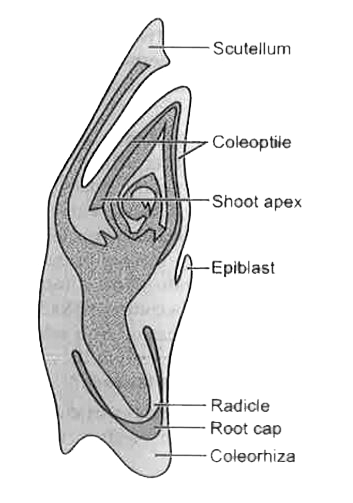In the embryos of a typical dicot and a grass, true homologous structures are : Solution in Kannada
Coleorhiza and coleoptile
Coleoptile and scutellum
Cotyledons and scutellum
b
Step by step video & image solution for In the embryos of a typical dicot and a grass, true homologous structures are : by Biology experts to help you in doubts & scoring excellent marks in Class 12 exams.
Topper's Solved these Questions
- BOOK - OSWAAL PUBLICATIONCHAPTER - SEXUAL REPRODUCTION IN FLOWERING PLANTS EXERCISE - TOPIC-2 LONG ANSWER TYPQ QUESTIONS6videos
SEXUAL REPRODUCTION IN FLOWERING PLANTS
- BOOK - OSWAAL PUBLICATIONCHAPTER - REPRODUCTIVE HEALTHEXERCISE - TOPIC-2 (SEXUALLY TRANSMITTED DISEASES AND INFERTILITY (MULTIPLE CHOICE QUESTIONS))13videos
REPRODUCTIVE HEALTH
- BOOK - OSWAAL PUBLICATIONCHAPTER - SOLVED PAPER II PUC TOPPER'S ANSWER MARCH - 2017EXERCISE - PART D (SECTION - II)5videos
SOLVED PAPER II PUC TOPPER'S ANSWER MARCH - 2017
Similar Questions
In the given diagram, write the names of parts shown with lines.
 05:36View Solution
05:36View SolutionThe method of directly injecting a sperm into ovum in assisted byreproductive technology is called :
03:50View SolutionExplain the components of a biogas plant with a neat labeled diagram.
03:44View SolutionThe female gametophyte (embryo sac( of a typical dicot (Polygonum) at the time of fertilization is
01:06View SolutionWhich are the structures of monocotyledonous embryo only, in not dicot embryo
04:37View SolutionThe embryo sac in a typical dicot at the time of fertilization is ________.
03:44View SolutionWhich of the following is correct information about a typical dicot embryo ?
02:17View SolutionIn the embryos of a typical dicot and a grass, true homologous structures are
02:21View SolutionThe embryo sac in a typical dicot at the time of fertilization is ________.
02:21View SolutionDescribe the structure of a typical dicotyledonous embryo.
03:22View SolutionThe true homologous compositions in a typical dicot and grass embryos are-
05:33View SolutionA typical dicot and a grass roots have true homologous structures.
02:55View SolutionWhat is embryo? Explain structure of monocot and dicot embryo.
01:16:24View SolutionIn the embryos of a typical dicot and a grass, true homologous structures are
(A) Coleorhiza and coleoptile
(B) Coleoptile and scutellum
(C) Cotyledons and scutellum
(D) Hypocotyl and radicle05:36View SolutionThe embryo of monocotyledons and dicotyledons show difference in structure. Explain the structure of dicot embryo.
03:52View SolutionSexual Reproduction in Flowering Plants|| Post-Fertilisation || Structures And Events of Embryo Development OF Embryo In Dicots || Development OF Embryo In Monocots
01:27View Solution

